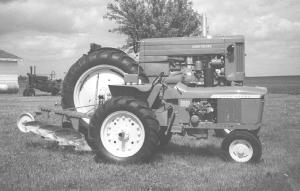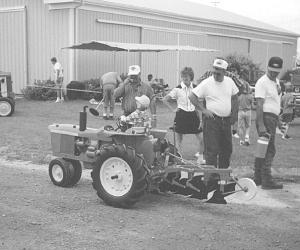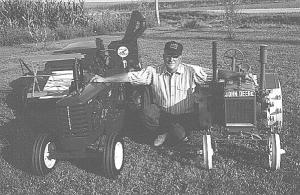1999 - Volume #23, Issue #4, Page #24
[ Sample Stories From This Issue | List of All Stories In This Issue | Print this story
| Read this issue]
1/2-Scale Farm Machinery Built "Just Like Real Thing"
 |
 |
 |
Peterman, who restores antique tractors for a living, started building his half-scale farm machinery several years ago. So far he has built a remote-controlled Deere 3020 tractor fitted with a 3-bottom moldboard plow; two steel-wheeled Deere GP tractors; and a Massey Harris 44 tractor hooked up to a pto-driven Clipper pull-type combine.
"I enjoy the challenge of trying to match the original as close as possible. There are no oversize seats or steering wheels on my tractors just so that someone can ride on them. They're a big hit at antique tractor shows and parades. In parades I'll sometimes walk alongside a tractor to drive it. Most of the time, though, I haul the tractors on a trailer."
The Deere 3020 is powered by a 16 hp, 3-cyl. Yanmar diesel engine. The engine is connected to the transmission off a Cub Cadet riding mower. Peterman used round steel tubing to make the axles and mounted 7.00 by 16 wheels on back and 8.00 by 4 wheels on front. He used steel pipe to make the steering wheel and made his own seat. The 3-pt. hitch, steering, and starting and stopping ability are all electric powered and can be remote controlled using a model airplane radio control unit.
"My wife Pat built a dummy driver that sits in the seat and holds onto the steering wheel. It really gets the attention of people when they see the dummy driving the tractor," says Peterman. "The tractor has a Roll-A-Matic front end which Deere used on the real tractor for years. Whenever the front end goes over an obstacle one wheel goes up in the air while the other one stays on the ground.
"The 810 moldboard plow has 14-in. moldboards and is built from aluminum which makes it lighter and easier to lift. I think it could actually plow but I've never used it for that. The tractor and plow took a total of 2,500 hours to build."
Peterman's half-size 1931 steel-wheeled Deere GP is powered by a 2-cyl., 10 hp LUC gas engine off a Deere 12A combine. The engine is tipped over sideways to resemble the tractor's original "flathead" engine. The transmission is from a Deere 45 combine. To make the seat he scaled down an actual full-size seat.
The lugs, rear wheels, and wheel spokes on the tractor were all hand made. The wheel spokes are made from strap iron and are hand riveted to the hub and welded to the rim.
"Deere GP models were built from 1929 to 1935. The flathead engine was the only horizontal ŠL' head engine Deere ever built. The real tractor was made for 3-row equipment which is why it never became very popular."
The 1952 Massey Harris 44 is powered by a 14 hp Kubota 3-cyl. diesel engine. It's a "Wheatland Standard" model equipped with a wide front end. The engine is connected to the transmission off a Cub Cadet riding mower.
The Clipper combine has a 3-ft. dia. wooden reel and a 3-ft. wide conveyor. To build it Peterman took the real combine apart and scaled all the parts down - except for the sieves and other threshing components which are full-size.
"The Clipper combine was very popular in the late 1940s," says Peterman. "The sieve holes on mine are sized to handle oats, so if I wanted I could use the combine to harvest oats. However, I've never used it for that because the unloading augers and other parts are so small that it would be difficult to clean all the material out of them."
Contact: FARM SHOW Followup, Ken Peterman, 1057 180th St., Webster City, Iowa 50595 (ph 515 543-8641).

Click here to download page story appeared in.

Click here to read entire issue
To read the rest of this story, download this issue below or click here to register with your account number.




